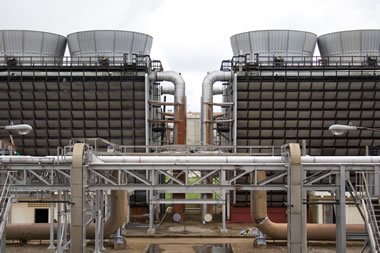Legionnaires’ Disease Outbreaks, are Cooling Towers High Risk?

When news of a Legionnaires’ disease outbreak makes the headlines, it’s not uncommon to later discover that a cooling tower was involved. While they are not always the root cause, cooling towers frequently feature in investigations and are often found to have played a central role in spreading Legionella bacteria over a wide area. Their design and operating conditions can create an environment in which the bacteria thrive if proper maintenance and controls are not in place, making them a well recognised risk in the battle against Legionnaires’.
In this article, we take a closer look at cooling towers and why they are often linked with outbreaks of Legionnaires’ disease. We explain what a cooling tower is and how it works, explore the conditions that make it susceptible to Legionella growth, and highlight examples of major outbreaks connected with poorly maintained systems. We also consider where cooling towers are typically found, the importance of effective risk management, regular testing and maintenance, and the steps organisations can take to manage the risks and keep people safe.
What is a cooling tower?
Put simply, a cooling tower is designed to remove heat from water, hence the name. Waste heat that is generated from buildings or production processes is extracted by a local cooling system. That heat is then transported and finally ejected into the atmosphere once it has been cooled by the tower.
The cooling process is achieved by mixing air and the heated water to lower the temperature of that water. Think of it as a huge fan inside the tower, working hard to cool the water and causing evaporation as it does so.
How is this relevant to the spread of Legionella bacteria?
Legionella bacteria is the organism that causes Legionnaires’ disease, a potentially fatal lung condition.
It loves to grow in water that is at just the right temperature… between 20 and 45 degrees Celsius. Anything above or below this temperature range won’t cause the bacteria to multiply.
temperatures between 20 and 45 degrees Celsius are ideal for legionella growth
Since a cooling tower deals with changing temperatures, there is an increased risk of the bacteria taking hold if not treated properly.
Legionnaires’ disease and Pontiac fever
If you know how Legionnaires’ disease is caused, you will also recognise the risks of contracting it from a cooling tower that has not been properly maintained.
Legionella bacteria must first be inhaled for it to cause harm, since it is associated with several lung conditions of varying severity. These conditions range from the relatively mild Pontiac fever to the potentially deadly Legionnaires’ disease.
Since a cooling tower emits evaporated water into the atmosphere, it can potentially create a scenario where Legionella contaminated water droplets are sent into the air and carried far and wide on the wind. These contaminated droplets can then be inhaled not just by those immediately near the cooling tower, but by anyone who is in the vicinity.
Studies have shown that fine airborne water droplets can travel several kilometres from the site of a cooling tower
It is this spread of water droplets that could contain Legionella bacteria that is most concerning. If a cooling tower is not properly tested, cleaned and maintained on a regular basis, it can easily become a real danger to people across a wide area.
The Disneyland cooling tower outbreak
Perhaps one of the most famous (or infamous) outbreaks of Legionnaires’ disease in recent times occurred at the Disneyland park in Los Angeles USA in 2017. A series of Legionnaires’ disease diagnoses were made by authorities towards the end of that year.
investigations found Legionella bacteria inside two cooling towers
It was discovered those affected had either spent time in the immediate area surrounding the park in Anaheim or had visited the park. All those affected were aged 52 or older.
One death occurred in someone who already had other health problems before contracting the disease. Following the investigations Legionella bacteria was found inside two of the cooling towers at the Disneyland theme park, both were subsequently shut down. While the towers were not in a publicly accessible area of the park, the nature of the cooling towers meant that some who had visited the park had fallen ill and were diagnosed with the Legionnaires’.
Other cooling tower related outbreaks of Legionnaires’
There have been many other Legionnaires’ outbreaks related to cooling towers across the world, including:
- Adelaide in Australia in 1986
- Sydney in Australia in 1989
- Murcia in Spain in 2001
- Pas-de-Calais in France in 2003-4
- Toronto in Canada in 2005
- Edinburgh in UK in 2012
- Boldon in UK in 2015
Many other cases have also occurred since.
Cooling towers can often be at the heart of major outbreaks because they have the potential to spread contaminated water vapour over large areas. This means not only those with direct contact with the water systems are affected, but anyone who happens to be nearby when the water droplets blow in their direction.
Which properties and businesses have cooling towers?
Cooling towers can be found in many locations around the world. Hospitals, hotels and offices use them… theme parks use them, as we have seen. Many large businesses, power plants and factories also use them.
It is recognised that these towers can easily provide the perfect conditions for Legionella and other bacteria to grow and multiply very quickly. It is estimated by some experts that the bacteria are found in at least 60% of all cooling towers, and possibly as many as 80% of them.
Cooling tower maintenance and water treatment
If these towers are properly maintained, however, the levels of bacteria present can be controlled to remain below critical levels.
Focusing on prevention and good water treatment practices is key to minimising the chance of any outbreaks of Legionnaires’ disease. Regular testing and cleaning should be done, along with proper treatment to ensure bacteria is not given the chance to grow.
Replacing defective and old or damaged tower parts also minimises the chance of biofilm forming on those components and using rust, organic matter and similar nutrients to grow to dangerous levels.
It is possible to hire a specialist company to undertake all your testing, maintenance and cleaning requirements for cooling towers and this is highly recommended. In the end, this is probably the best preventative step anyone could take to prevent their cooling towers form causing an outbreak of Legionnaires’ disease.
Legionella and water safety specialists
Our teams of legionella and water safety specialists support those responsible for the control of legionella in cooling towers and other water systems, helping them to protect people and meet their health and safety obligations in this specialist area.
We deliver professional water safety risk assessments for legionella, pseudomonas and other waterborne pathogens, water testing, independent compliance auditing, City & Guilds training and other environmental risk management services that help keep staff and others safe.


